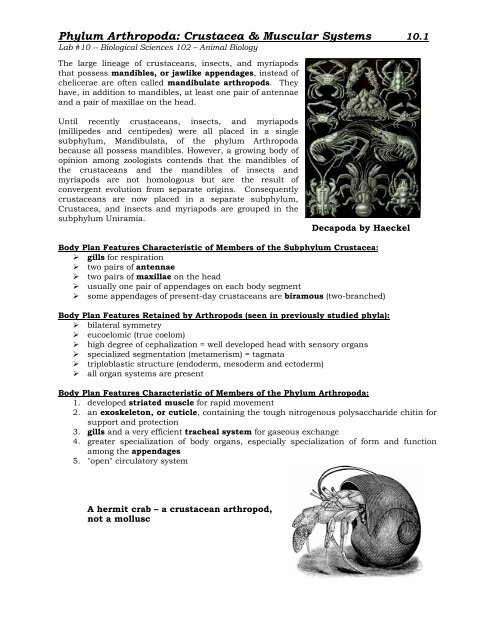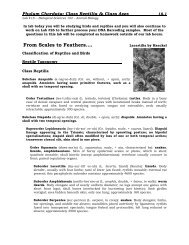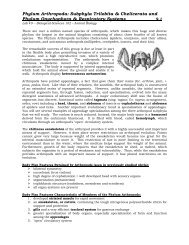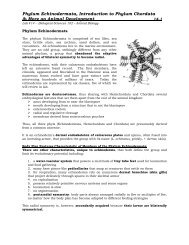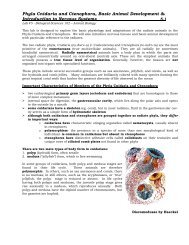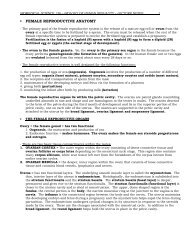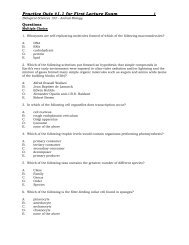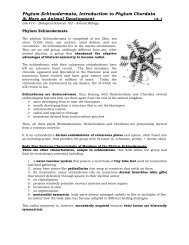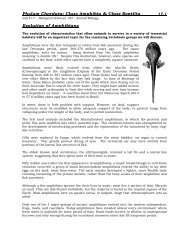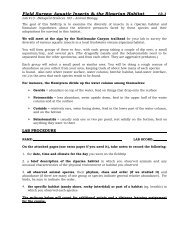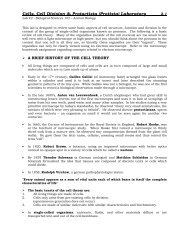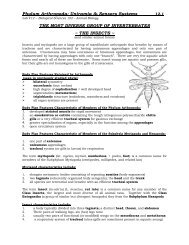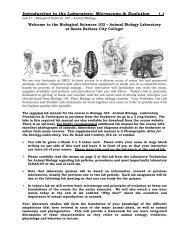Phylum Arthropoda: Crustacea & Muscular Systems - Biosciweb.net
Phylum Arthropoda: Crustacea & Muscular Systems - Biosciweb.net
Phylum Arthropoda: Crustacea & Muscular Systems - Biosciweb.net
Create successful ePaper yourself
Turn your PDF publications into a flip-book with our unique Google optimized e-Paper software.
<strong>Phylum</strong> <strong>Arthropoda</strong>: <strong>Crustacea</strong> & <strong>Muscular</strong> <strong>Systems</strong> 10.1<br />
Lab #10 -- Biological Sciences 102 – Animal Biology<br />
The large lineage of crustaceans, insects, and myriapods<br />
that possess mandibles, or jawlike appendages, instead of<br />
chelicerae are often called mandibulate arthropods. They<br />
have, in addition to mandibles, at least one pair of antennae<br />
and a pair of maxillae on the head.<br />
Until recently crustaceans, insects, and myriapods<br />
(millipedes and centipedes) were all placed in a single<br />
subphylum, Mandibulata, of the phylum <strong>Arthropoda</strong><br />
because all possess mandibles. However, a growing body of<br />
opinion among zoologists contends that the mandibles of<br />
the crustaceans and the mandibles of insects and<br />
myriapods are not homologous but are the result of<br />
convergent evolution from separate origins. Consequently<br />
crustaceans are now placed in a separate subphylum,<br />
<strong>Crustacea</strong>, and insects and myriapods are grouped in the<br />
subphylum Uniramia.<br />
Decapoda by Haeckel<br />
Body Plan Features Characteristic of Members of the Subphylum <strong>Crustacea</strong>:<br />
‣ gills for respiration<br />
‣ two pairs of antennae<br />
‣ two pairs of maxillae on the head<br />
‣ usually one pair of appendages on each body segment<br />
‣ some appendages of present-day crustaceans are biramous (two-branched)<br />
Body Plan Features Retained by Arthropods (seen in previously studied phyla):<br />
‣ bilateral symmetry<br />
‣ eucoelomic (true coelom)<br />
‣ high degree of cephalization = well developed head with sensory organs<br />
‣ specialized segmentation (metamerism) = tagmata<br />
‣ triploblastic structure (endoderm, mesoderm and ectoderm)<br />
‣ all organ systems are present<br />
Body Plan Features Characteristic of Members of the <strong>Phylum</strong> <strong>Arthropoda</strong>:<br />
1. developed striated muscle for rapid movement<br />
2. an exoskeleton, or cuticle, containing the tough nitrogenous polysaccharide chitin for<br />
support and protection<br />
3. gills and a very efficient tracheal system for gaseous exchange<br />
4. greater specialization of body organs, especially specialization of form and function<br />
among the appendages<br />
5. "open" circulatory system<br />
A hermit crab – a crustacean arthropod,<br />
not a mollusc
<strong>Phylum</strong> <strong>Arthropoda</strong>: <strong>Crustacea</strong> & <strong>Muscular</strong> <strong>Systems</strong> 10.2<br />
Lab #10 -- Biological Sciences 102 – Animal Biology<br />
<strong>Phylum</strong> <strong>Arthropoda</strong><br />
Classification<br />
Subphylum Trilobita (tri'lo-bi'ta) (Gr. tri, three, + lobos, lobe). Trilobites. All extinct forms;<br />
Cambrian to Carboniferous; body divided by two longitudinal furrows into three lobes; distinct<br />
head, thorax, and abdomen; biramous (two-branched) appendages.<br />
Subphylum Chelicerata (ke-liss'uh-ra'ta) (Gr. chele, claw, + keras, horn, + ata, group<br />
suffix). Eurypterids, horseshoe crabs, spiders, and ticks. First pair of appendages modified<br />
to form chelicerae; pair of pedipalps and four pairs of legs; no antennae, no mandibles;<br />
cephalothorax and abdomen usually unsegmented.<br />
See Lab #10 for more detailed taxonomy of the Subphylum Chelicerata<br />
Subphylum <strong>Crustacea</strong> (crus-ta'she-a) (L crusta, shell, + acea, group suffix). About 45,000<br />
species. <strong>Crustacea</strong>ns. With gills; body covered with carapace; exoskeleton with limy salts;<br />
appendages currently considered biramous and variously modified for different functions;<br />
head with two pairs of antennae.<br />
Class Remipedia (about 10 species that dwell in caves connected to the sea)<br />
Class Cephalocarida (about 10 species; only true hermaphroditic arthropods)<br />
Class Malacostraca (about 20,000 species)<br />
Order Decapoda (shrimps, lobsters, crabs, crayfish = about 18,000 species)<br />
Order Isopoda (dorsoventrally flattened; pill bugs or roly-polies = Armadillidium,<br />
kelp lice, etc.)<br />
Order Amphipoda (laterally flattened; beach hoppers = Orchestia, etc.)<br />
Order Euphausiacea (krill; look like small shrimp with external exposed gills)<br />
Class Branchipoda (have ventral phyllopodia - “leaf-like appendages” - for respiration;<br />
fairy shrimp, brine shrimp, tadpole shrimp, water fleas)<br />
Class Ostracoda (have a bivalve carapace; only two trunk appendages; mussel shrimp<br />
or seed shrimp)<br />
Class Maxillopoda (Copepoda, Tantulocarida, Branchiura, Cirripedia)<br />
Subclass Copepoda (copepods)<br />
Subclass Thecostraca (barnacles & about 100 species of small crustaceans that<br />
are parasites of cnidarians and echinoderms)<br />
Infraclass Cirripedia (barnacles; gooseneck, acorn & buckshot barnacles)<br />
Order Rhizocephalans such as Sacculina are crab parasites<br />
Subphylum Myriapoda Myriapods. All appendages uniramous; head appendages consisting<br />
of one pair of antennae, one pair of mandibles, and one or two pairs of maxillae.<br />
Subphylum Hexapoda Hexapods.<br />
Class Insecta (in-sek'ta) (L. insectus, cut into). About one million species. Insects.<br />
Body with distinct head, thorax, and abdomen; thorax usually with two pairs of<br />
wings; three pairs of jointed legs. Example: lubber grasshopper, Romalea.<br />
See Lab #12 for more detailed taxonomy of the Subphyla Myriapoda and Hexapoda.
<strong>Phylum</strong> <strong>Arthropoda</strong>: <strong>Crustacea</strong> & <strong>Muscular</strong> <strong>Systems</strong> 10.3<br />
Lab #10 -- Biological Sciences 102 – Animal Biology<br />
<strong>Muscular</strong> <strong>Systems</strong>: Types of Muscle Cells<br />
Muscles are specialized organs comprised of cells that are both electrically excitable (they can<br />
conduct action potentials) and contractile. This contractibility allows muscles to move the<br />
bones found in appendages or against a hydrostatic skeleton as well as to manipulate internal<br />
organs and structures. The cell structure of skeletal cells that control body movements is<br />
different from that of the smooth muscle cells that operate in the digestive, cardiovascular,<br />
respiratory, reproductive, etc. organ systems. Cardiac muscle cells have specialized<br />
connections for electrical conduction (gap junctions) and protein connections between cell<br />
membranes (desmosomes) which are critical to the normal functioning of the heart and the<br />
effective pumping of blood.<br />
muscle fiber = elongated multinucleate skeletal muscle cell<br />
Muscles are made of specialized fibrous cells that contain the specialized muscle protein fibers<br />
(actin and myosin among others). These fibers are packed together into myofibrils which in<br />
turn are packed together to form a muscle. We will review the basic functional unit of muscle<br />
called a sarcomere later in lecture.<br />
Three Basic Tvpes of Muscle Tissue:<br />
Some types are not found in some animals<br />
1. Skeletal muscle = moves bones/skeleton, voluntary respiratory organs, eyes, mouth, etc.<br />
‣ skeletal muscle fibers are long, cylindrical multinucleate muscle cells or fibers (they<br />
form a syncitium)<br />
‣ skeletal muscle is striated<br />
‣ under voluntary control<br />
2. Smooth muscle = circle the digestive tract, blood vessels, respiratory, reproductive and<br />
urinary ducts; make up parts of many internal organs<br />
‣ smooth muscle cells are long, tapering strands that are not multinucleate<br />
(=uninucleate)<br />
‣ smooth muscle is not striated<br />
‣ under involuntary control<br />
3. Cardiac muscle = heart muscle only<br />
‣ cardiac muscle is composed of the fast acting, uninucleate muscle cells that make<br />
up the heart<br />
‣ cardiac muscle is not striated<br />
‣ under involuntary control<br />
‣ due to specialized connections between cardiac muscle cells called intercalated<br />
disks, the cells which make up a chamber of the heart can beat in unison for the<br />
efficient pumping of blood. Intercalated disks contain cell-to-cell connections called<br />
gap junctions and desmosomes<br />
motor neurons = neurons that innervate skeletal muscle fibers<br />
motor unit = a motor neuron can divide and form neuromuscular junctions with several<br />
(sometimes thousands) of skeletal muscle fibers. The motor neuron plus the skeletal muscle<br />
fibers it innervates make up a motor unit. When a motor neuron fires, all of the muscle fibers<br />
that it innervates will contract.
<strong>Phylum</strong> <strong>Arthropoda</strong>: <strong>Crustacea</strong> & <strong>Muscular</strong> <strong>Systems</strong> 10.4<br />
Lab #10 -- Biological Sciences 102 – Animal Biology<br />
LAB PROCEDURE<br />
NAME:<br />
LAB SCORE:<br />
Refer to the textbook and Inter<strong>net</strong> for illustrations, diagrams, and<br />
additional information about crustaceans.<br />
Observation of Living Specimens<br />
Subphylum <strong>Crustacea</strong><br />
Class Branchiopoda (branciopods) – see slide presented by instructor<br />
‣ Observe the specimens and/or diagrams of a branchiopod.<br />
‣ Record the descriptive information requested at the end of the lab for this species.<br />
Subphylum <strong>Crustacea</strong><br />
Class Maxillopoda<br />
Subclass Copepoda (copepods) – see slide presented by instructor<br />
‣ Observe the specimens and/or diagrams of the copepod, Cyclops. sp.<br />
‣ Record the descriptive information requested at the end of the lab for this species.<br />
Subphylum <strong>Crustacea</strong><br />
Class Maxillopoda<br />
Subclass Thecostraca<br />
Infraclass Cirripedia<br />
‣ Observe the specimens and/or diagrams of the gooseneck barnacle,<br />
Polycipes polymerus<br />
‣ Record the descriptive information requested at the end of the lab for this species.<br />
Subphylum <strong>Crustacea</strong><br />
Class Maxillopoda<br />
Subclass Thecostraca<br />
Infraclass Cirripedia<br />
‣ Observe the specimens and/or diagrams of one member of the genus, Balanus.<br />
‣ Record the descriptive information requested at the end of the lab for this species.<br />
Subphylum <strong>Crustacea</strong><br />
Class Malacostraca (19 body segments)<br />
Order Amphipoda (amphipods)<br />
A caprellid (skeleton shrimp)<br />
An amphipod<br />
‣ Observe one of the specimens and/or diagrams of an amphipod on display.<br />
‣ Record the descriptive information requested at the end of the lab for this species.<br />
Subphylum <strong>Crustacea</strong><br />
Class Malacostraca<br />
Order Isopoda (isopods)<br />
‣ Observe one of the specimens and/or diagrams of an isopods on display.<br />
‣ Record the descriptive information requested at the end of the lab for this species.<br />
‣ If available, observe the terrestrial isopod, Armadillidium vulgare on display.<br />
Realize that this animal commonly known as the "pillbug" or “rollie-pollie” is a<br />
crustacean and not an insect.
<strong>Phylum</strong> <strong>Arthropoda</strong>: <strong>Crustacea</strong> & <strong>Muscular</strong> <strong>Systems</strong> 10.5<br />
Lab #10 -- Biological Sciences 102 – Animal Biology<br />
Subphylum <strong>Crustacea</strong><br />
Class Malacostraca<br />
Order Decapoda (shrimps, lobsters and crabs)<br />
‣ Observe one of the specimens and/or diagrams of on display of each of the following<br />
infraorders (as available).<br />
‣ Record the descriptive information requested at the end of the lab for this species.<br />
Infraorder Caridea<br />
(shrimp)<br />
‣ What does the word Caridea mean (what is its etymology)?<br />
Infraorder Astacidea<br />
(crawfish & clawed lobsters), the crayfish, Procambarus, sp.<br />
‣ What does the word Astacidea mean (what is its etymology)?<br />
Infraorder Palinura<br />
(spiny lobsters) such as Panulirus interuptus<br />
‣ What does the word Palinura mean (what is its etymology)?<br />
Infraorder Anomura<br />
(crabs with antennae lateral to eyes)<br />
a hermit crab such as Pagurus sp. or Isocheles sp.<br />
a Galatheid crab such as Petrolisthes sp. or. Pachychelis sp.<br />
a Hippid crab such as Emerita sp. or Blepharipoda sp.<br />
‣ What does the word Anomura mean (what is its etymology)?<br />
Infraorder Thalassinidea<br />
(mud or ghost shrimp) such as Callianassa sp.<br />
‣ What does the word Thalassinidea mean (what is its etymology)?<br />
Infraorder Brachyura<br />
(Crabs with antennae between the eyes) such as Cancer sp.<br />
‣ What does the word Brachyura mean (what is its etymology)?
<strong>Phylum</strong> <strong>Arthropoda</strong>: <strong>Crustacea</strong> & <strong>Muscular</strong> <strong>Systems</strong> 10.6<br />
Lab #10 -- Biological Sciences 102 – Animal Biology<br />
DISSECTION<br />
Class Malacostraca<br />
Order Decapoda<br />
Procambarus, sp. (Crayfish)<br />
Obtain a living crayfish. Observe the movements and behavior of your specimen.<br />
‣ Which crayfish appendages are involved in respiratory movements?<br />
‣ Which legs are involved in walking?<br />
‣ What is the apparent function of the antennae?<br />
‣ How does the crayfish right itself – describe the righting response?<br />
‣ When the crayfish flexes its tail rapidly in the water, what function does it<br />
serve?<br />
‣ In what direction is the animal propelled when it does this movement?<br />
‣ What chela (pincer) muscles are strongest, those which close pincers or those<br />
that open them?<br />
‣ What are the advantages of an exoskeleton?<br />
‣ What are the disadvantages of an exoskeleton?
<strong>Phylum</strong> <strong>Arthropoda</strong>: <strong>Crustacea</strong> & <strong>Muscular</strong> <strong>Systems</strong> 10.7<br />
Lab #10 -- Biological Sciences 102 – Animal Biology<br />
‣ Examine the external anatomy of the crayfish on both the dorsal and ventral<br />
sides and be able to identify the following structures:<br />
External Morphology<br />
‣ cephalothorax<br />
‣ abdomen<br />
‣ carapace<br />
‣ telson<br />
‣ rostrum<br />
‣ uropods<br />
Paired Appendages<br />
‣ antennae<br />
‣ antennules<br />
‣ chelipeds<br />
‣ four pairs of walking legs<br />
‣ pleopods (swimmerets)<br />
‣ thoracic and cephalic feeding appendages (maxillopeds and mandibles)<br />
‣ Which of these appendages are cephalic?<br />
‣ Which of these appendages are thoracic?<br />
‣ Is your crayfish a male or a female?<br />
After you have completed your study of the live specimen, place it in boiling water, and<br />
after a brief period, remove it and allow to cool. Hold the crayfish and cut through the<br />
back of the carapace along the dotted line indicated (see pg. 11.9). Cut through the<br />
thoracic region just internal to the branchiostegal line. If the crayfish is about to molt,<br />
there will be a thin sheet of unhardened chitin inside the hardened exoskeleton. This<br />
should be stripped off with forceps.<br />
Next, cut along the dotted line indicated on pg. 11.9 to remove the left branchiostegite<br />
and reveal the gills. After observing the gills, and removing them, cut along the dotted<br />
lines indicated on pg. 11.9 to remove the side wall of the thorax and the head.
<strong>Phylum</strong> <strong>Arthropoda</strong>: <strong>Crustacea</strong> & <strong>Muscular</strong> <strong>Systems</strong> 10.8<br />
Lab #10 -- Biological Sciences 102 – Animal Biology<br />
Internal Structures to Identify on the Crayfish (you may find others)<br />
‣ heart (as visible)<br />
‣ stomach<br />
‣ gastric mill (“little teeth” in the stomach)<br />
‣ gastroliths (if present in the stomach)<br />
‣ gills (lateral sides of thorax)<br />
‣ green glands (whitish and circular; at the very anterior ventral portion inside the<br />
head at the base of the antennae)<br />
Did you find gastroliths during your dissection?<br />
If so, briefly describe their appearance and texture.<br />
‣ What is the function of the gastroliths?<br />
‣ Why might marine crustaceans lack gastroliths?<br />
‣ What types of molecules and ions comprise the exoskeleton of most crustaceans?
<strong>Phylum</strong> <strong>Arthropoda</strong>: <strong>Crustacea</strong> & <strong>Muscular</strong> <strong>Systems</strong> 10.9<br />
Lab #10 -- Biological Sciences 102 – Animal Biology
<strong>Phylum</strong> <strong>Arthropoda</strong>: <strong>Crustacea</strong> & <strong>Muscular</strong> <strong>Systems</strong> 10.10<br />
Lab #10 -- Biological Sciences 102 – Animal Biology
<strong>Phylum</strong> <strong>Arthropoda</strong>: <strong>Crustacea</strong> & <strong>Muscular</strong> <strong>Systems</strong> 10.11<br />
Lab #10 -- Biological Sciences 102 – Animal Biology<br />
SPECIMEN STUDY/DISSECTION<br />
Class Malacostraca<br />
Order Decapoda<br />
Crab<br />
On the COOKED or a LIVE crab displayed in the lab, identify the external structures listed<br />
below.<br />
Scientific name of crab specimen:<br />
Infraorder of crab specimen:<br />
External Structures to Identify on the Crab<br />
‣ cephalothorax (covered by the carapace)<br />
‣ abdomen (broad in females, narrow in males)<br />
‣ four pairs of walking legs<br />
‣ telson<br />
‣ rostral teeth<br />
‣ chelapeds<br />
‣ chelae<br />
‣ walking legs<br />
‣ Is your specimen a male or female?<br />
‣ Carefully lift the abdomen of the crab.<br />
‣ If male, are any abdominal appendages present? What might these be used for?<br />
‣ If female, are there any eggs being held and roughly how many eggs?<br />
‣ Crayfish have a green gland. Some crabs also have a green gland.<br />
What is the function of the green gland?<br />
‣ Which pairs of legs are chelate (biramous or bifurcated, like pincers)?
<strong>Phylum</strong> <strong>Arthropoda</strong>: <strong>Crustacea</strong> & <strong>Muscular</strong> <strong>Systems</strong> 10.12<br />
Lab #10 -- Biological Sciences 102 – Animal Biology<br />
‣ How does this compare with your observations of the crayfish?<br />
‣ Where are the gills located in a crayfish?<br />
‣ Where are the gills located in a crab typically?<br />
Your instructor will be coming around to each group to assist you and ask you<br />
to identify the structures listed in preparation for the invertebrate lab practical.<br />
‣ Place your crayfish specimen in the waste container provided.<br />
‣ Rinse your dissecting tray and clean your supplies and return them.
<strong>Phylum</strong> <strong>Arthropoda</strong>: <strong>Crustacea</strong> & <strong>Muscular</strong> <strong>Systems</strong> 10.13<br />
Lab #10 -- Biological Sciences 102 – Animal Biology
<strong>Phylum</strong> <strong>Arthropoda</strong>: <strong>Crustacea</strong> & <strong>Muscular</strong> <strong>Systems</strong> 10.14<br />
Lab #10 -- Biological Sciences 102 – Animal Biology<br />
Living Specimens Data<br />
Subphylum <strong>Crustacea</strong><br />
Class Branchiopoda (branchiopods) - see slide presented<br />
by instructor<br />
Scientific name:<br />
Common name:<br />
Notes & observations to help you remember and distinguish this group/species:<br />
Subphylum <strong>Crustacea</strong><br />
Class Maxillopoda<br />
Subclass Copepoda (copepods) – see slide<br />
presented by instructor<br />
Scientific name:<br />
Common name:<br />
Notes & observations to help you remember and distinguish this group/species:<br />
Subphylum <strong>Crustacea</strong><br />
Subclass Thecostraca<br />
Infraclass Cirripedia<br />
Scientific name:<br />
Common name:<br />
Is there a stalk present in this species?<br />
Notes & observations to help you remember and distinguish this group/species:
<strong>Phylum</strong> <strong>Arthropoda</strong>: <strong>Crustacea</strong> & <strong>Muscular</strong> <strong>Systems</strong> 10.15<br />
Lab #10 -- Biological Sciences 102 – Animal Biology<br />
Subphylum <strong>Crustacea</strong><br />
Subclass Thecostraca<br />
Infraclass Cirripedia<br />
Scientific name:<br />
Common name:<br />
Is there a stalk present in this species?<br />
Notes & observations to help you remember and distinguish this group/species:<br />
Subphylum <strong>Crustacea</strong><br />
Class Malacostraca<br />
Order Amphipoda<br />
Scientific name:<br />
Common name:<br />
Is this specimen dorso-ventrally or laterally flattened?<br />
Notes & observations to help you remember and distinguish this group/species:<br />
Subphylum <strong>Crustacea</strong><br />
Class Malacostraca<br />
Order Isopoda<br />
Scientific name:<br />
Common name:<br />
Is this specimen dorso-ventrally or laterally flattened?<br />
Notes & observations to help you remember and distinguish this group/species:
<strong>Phylum</strong> <strong>Arthropoda</strong>: <strong>Crustacea</strong> & <strong>Muscular</strong> <strong>Systems</strong> 10.16<br />
Lab #10 -- Biological Sciences 102 – Animal Biology<br />
Subphylum <strong>Crustacea</strong><br />
Class Malacostraca<br />
Order Decapoda<br />
Infraorder Caridea<br />
Scientific name:<br />
Common name:<br />
Is this specimen dorso-ventrally or laterally flattened?<br />
Notes & observations to help you remember and distinguish this group/species:<br />
Infraorder Astacidea, the crayfish, Procambarus, sp.<br />
Scientific name:<br />
Common name:<br />
Notes & observations to help you remember and<br />
distinguish this group/species:<br />
Infraorder Palinura such as Panulirus interuptus<br />
Scientific name:<br />
Common name:<br />
Notes & observations to help you remember and distinguish<br />
this group/species:<br />
Infraorder Anomura, a hermit crab such as Pagurus sp. or Isocheles sp.<br />
Scientific name:<br />
Common name:<br />
Notes & observations to help you remember and distinguish this group/species:
<strong>Phylum</strong> <strong>Arthropoda</strong>: <strong>Crustacea</strong> & <strong>Muscular</strong> <strong>Systems</strong> 10.17<br />
Lab #10 -- Biological Sciences 102 – Animal Biology<br />
Infraorder Anomura, a Galatheid crab such as Petrolisthes sp. or. Pachychelis sp.<br />
Scientific name:<br />
Common name:<br />
Notes & observations to help you remember and distinguish this group/species:<br />
Infraorder Anomura, a Hippid crab such as Emerita sp. or Blepharipoda sp.<br />
Scientific name:<br />
Common name:<br />
Notes & observations to help you remember and distinguish this group/species:<br />
Infraorder Thalassinidea such as Callianassa sp.<br />
Scientific name:<br />
Common name:<br />
Notes & observations to help you remember and distinguish this group/species:<br />
Infraorder Brachyura such as Cancer sp.<br />
Scientific name:<br />
Common name:<br />
Notes & observations to help you remember and distinguish this group/species:
<strong>Phylum</strong> <strong>Arthropoda</strong>: <strong>Crustacea</strong> & <strong>Muscular</strong> <strong>Systems</strong> 10.18<br />
Lab #10 -- Biological Sciences 102 – Animal Biology<br />
Subphylum <strong>Crustacea</strong><br />
Class Malacostraca<br />
Order Euphausiacea (krill)<br />
Scientific name:<br />
Common name:<br />
Is this specimen dorso-ventrally or laterally flattened?<br />
Notes & observations to help you remember and distinguish this group/species:<br />
Homework – use the Inter<strong>net</strong> to help you answer these questions:<br />
‣ This is a nauplius larva of a crustacean. Briefly describe<br />
and/or draw a flowchart diagram to show the lifecycle of a<br />
decapod. Be sure to include the names of specific larval<br />
stages.<br />
Nauplius larva
<strong>Phylum</strong> <strong>Arthropoda</strong>: <strong>Crustacea</strong> & <strong>Muscular</strong> <strong>Systems</strong> 10.19<br />
Lab #10 -- Biological Sciences 102 – Animal Biology<br />
Sacculina are crab parasites<br />
‣ To what class and order do the Sacculina crab<br />
parasites belong?<br />
‣ Briefly describe and/or draw a flowchart diagram to<br />
show the lifecycle of the Sacculina crab parasite.<br />
Be sure to include the names of specific larval<br />
stages.<br />
‣ In which class and order does the mantis shrimp belong?<br />
‣ Briefly describe how mantis shrimp (stomatopods) capture their prey.
<strong>Phylum</strong> <strong>Arthropoda</strong>: <strong>Crustacea</strong> & <strong>Muscular</strong> <strong>Systems</strong> 10.20<br />
Lab #10 -- Biological Sciences 102 – Animal Biology<br />
LABORATORY NOTES:<br />
Copepoda by Haeckel


